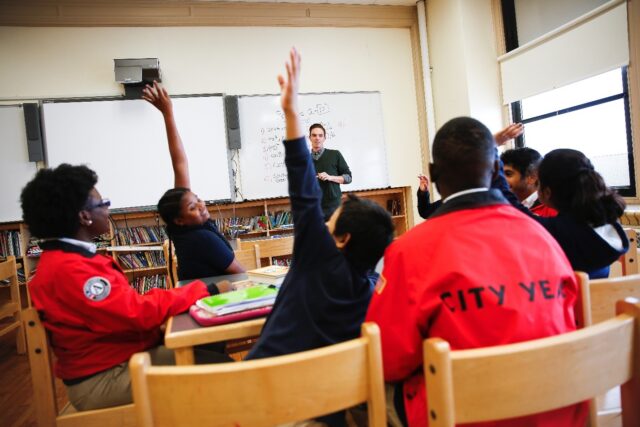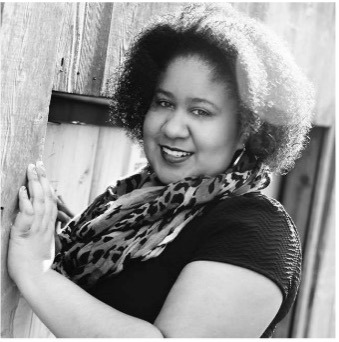Top five questions you have about City Year service, answered
Ines Brookens, City Year Chicago ’13, ’14, is not only an alum, she’s also a City Year service year adviser supporting future AmeriCorps members for City Year Chicago. As an adviser, Ines helps guide incoming AmeriCorps members from the time they accept the offer to serve through registration.
While service looks different across our 29 sites—and each service year adviser takes a localized approach—we know many fields similar questions.
So, we sat down with Ines to answer the top five questions she hears from the field.

How does team placement work?
Service with City Year happens on many different levels—between an AmeriCorps member and a student or a group of students; between an AmeriCorps member and their partner teacher; and through the relationships corps members form with other members of their school-based team. In fact, for many AmeriCorps members, working on a diverse team with their peers becomes one of the most valuable aspects of service with City Year.
“Every AmeriCorps member works to support their students and school communities on teams,” says Ines. “Many confirmed corps members ask this question because they want to find housing near their school community.
“The process of organizing corps members into teams looks different from site to site. However, it is unlikely that you’ll know your team/school placement before the start of service. In that case, I suggest that folks reach out to their service year adviser to understand which neighborhoods their City Year site serves.
“Take Chicago, for example; we only serve schools on the west and south side. So, I tell my confirmed corps members to look for housing in these two areas if they want to prevent a long commute to service each morning.”
What does a typical “day in the life” look like with City Year?
“You’ll hear me say this a lot: things will look different from school to school!
“We won’t be able to tell you exactly what your day will be like—and with an experience like City Year, each day will bring its own challenges (and adventures)!
“However, I can give you a general outline of how your do will go:
“You’ll start your day early with your team, checking in and going over the schedule for the day. This meeting happens before the students have begun to arrive at school. Once the students start arriving, you’ll be there to greet them with a smile and positive energy to make sure they start their school day on a good note. Throughout the day, you either do small group tutoring sessions or work one-on-one with students and provide whole classroom support to teachers.
“Once the school day is over, you’ll move into afterschool programming. Afterschool support can be a range of things. You could help students with their homework, or you could have an enrichment program (think Spanish club or engineering club. Get creative)!
“I always tell people that you start service before the students arrive in the building and end service after they leave. It’s a long day, but this is what educators (and the professionals who support them) do to make sure that the students are getting the kind of support they need.”
What is something you wish you had known before starting service?
“City Year teams have something called “coordinator roles.” This means that every team member has a designated function besides the classroom-based work you do with your students. For example, one member of your team could be the afterschool coordinator, providing targeted support for logistics or programming. Your team could also have a communications coordinator who runs the team’s social media accounts or writes newsletters. There can also be coordinators who oversee math and literacy enrichment.
These coordinator roles help you build leadership skills like project and event planning, delegation, collaboration, etc. And these are all skills that will help prepare you for your post-service career.”
How will City Year help with my career?
“A City Year AmeriCorps member’s primary goal is to help students thrive in their learning environments. But City Year can also support you and provide resources for a career outside of the education sector. Each site will host a series of LACY (Leadership After City Year) programs throughout the service year.
“LACY programming often included career fairs, shadow days, mentorship programs, and other networking opportunities. You’ll have the chance to speak with City Year alums who pursued diverse career paths after completing service.
“So, if you’re looking to be an educator—that’s awesome! City Year is a great place to start. But if you’re not looking to go into education, know that you are not alone in that! Many City Year alums go one to have successful careers in law, business, medicine, counseling and psychology and many other professions.”
What’s the best and most challenging thing about City Year?
“For me, the opportunity to build meaningful and caring relationships with my students is the best thing. I had a student who was shy and who would never speak in class or ask for help. I decided that I would try to get to know her, and so throughout the year, I worked continuously with this student.
“By the end of the year, we had built a solid relationship. She went from being a student who would never talk in class to the kind of student who would raise her hand if she needed help or had a question in math. If she was having a tough time with other students, she would go to the counselor’s office instead of lashing out.
“At the end of my service, my student still had her personal and academic struggles, but I was proud that she was in a position where she felt more confident in advocating for herself.
“The hardest part about City Year is wrapped up in the best part about City Year, in my experience. Supporting kids through their social-emotional needs is challenging. Sometimes you feel like you’re taking two steps forward and three steps back. In many cases, you don’t always get to see that you’re making a difference with the student. It can be like planting a seed without ever getting the privilege and opportunity to see it grow.”
Ready to start your application journey? Click here to learn more or start your City Year application:

Related stories
Because you'll be living on a stipend, it might be a good idea to hold off on that ottoman from...
Read more about Furnishing your apartment on a budget: Tips for AmeriCorps membersCity Year’s “Why We Matter” podcast explores the vital role of education and mentorship in empowering young people. Through interviews...
Read more about Why City Year’s student success coach network mattersRead more and check the City Year blog to learn the soft skills our corps members gain through a year...
Read more about Top five skills employers want you to have todayIf you speak with an alum of an historically Black college or university (HBCU) about their experience, you’ll quickly learn...
Read more about Serving with City Year sharpens job skills, HBCU graduate says















